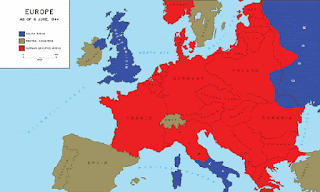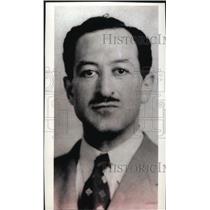by Marc Masurovsky
The purpose of this presentation is to place the search for and recovery of Nazi looted art on the European continent in the context of broader Allied policies framed to disentangle the postwar world from the vicissitudes generated by years of Nazi policies of persecution, exploitation and extermination. One of the most brazen efforts aimed at severing the postwar world from the clutches of Nazism was Operation Safehaven, an Anglo-American program whose goal was to neutralize and eliminate any evidence—physical and corporate—of Nazi influence, defined as broadly as possible, worldwide, but mostly in war-torn Europe and, in particular, in the so-called “neutral” countries, the non-belligerents of WWII—Portugal, Spain, Switzerland and Sweden.
 |
| Neutral countries (in tan) during WWII |
With regard to the specific campaign of plunder waged by Nazi agents and officials across occupied Europe, Safehaven’s natural targets encompassed looted cultural objects, regardless of value and significance, and their possessors, traders, and recyclers, the orchestrators of these crimes, who were fit to be considered as “enemy agents” involved in abetting Nazi post-defeat plans in a liberated postwar world.
While the Safehaven program came into being in the summer and fall of 1944, three art commissions were established to assess and address the problem of cultural damage across Europe and more precisely assess cultural losses suffered by institutions and individuals and remedy them as well and equitably as possible.
Various Allied declarations against Axis looting in occupied Europe laid the groundwork for the Safehaven program and its treatment of neutral countries:
To be fair, Safehaven being ostensibly an Anglo-American program, it was burdened, from the outset, by historic and often virulent rivalries and mutual enmity between the United States and Great Britain. The Safehaven program evolved in an environment of acute economic competition and rivalry between the the US and Great Britain which influenced the policy-making process underlying Safehaven. As an example, viewed from the British side, the Safehaven program was the American government’s Trojan Horse aimed at breaching the protectionist barriers of British Imperial trade preferences surrounding its Empire.
Nevertheless, the Safehaven program arose from a legitimate security concern expressed by the Allies over a possible continuation of Nazi activity in the post-war era, using commercial covers, neutral benevolence, and significant pro-Axis sentiment in the neutrals, liberated countries and some of the United Nations. Overall, the Americans were far more strident on this point than the British.
Although Safehaven was outwardly a security-based program designed to neutralize Nazi strongholds in the neutral countries, it morphed into an instrument of foreign economic policy aimed at establishing American pre-eminence in the post-war world. If Pax Anglo-Americana prevailed during the interwar years, the goal of the American government, in the words of Henry Morgenthau, Treasury Secretary uner Franklin D. Roosevelt, was to establish a “Pax Americana” at war’s end.
 |
| Henry Morgenthau, courtesy of USHMM |
 |
| Samuel Klaus |
The British government was keenly aware of this possibility, which explains its reluctance to join in the Safehaven program. Moreover, Samuel Klaus, the American official who “thought up” Safehaven, was an anti-trust and anti-cartel specialist/activist at the Foreign Economic Administration (FEA), the main American agency responsible for the US economic warfare strategy. Its British equivalent was the Ministry of Economic Warfare (MEW). Klaus’ worldview was shaped by the anti-monopolist, anti-corporate combination mentality of the New Deal. And so were those of many of his colleagues
In the field, the challenges faced by Safehaven were most noticeable in Spain, led by a military dictator, Generalissimo Francisco Franco.
 |
| Francisco Franco |
The future of Safehaven lay in the collection of reliable raw intelligence from the field—continental Europe still in the throes of Nazi and Fascist control and occupation—requiring extensive coordination with espionage agents, clandestine operatives, and informants operating under cloak. Once collected, where were the data concentrated? Analyzed by whom? Distributed to whom? Such considerations, logistical, bureaucratic, and political, compelled a semblance of coordination and centralization of responsibilities where no such centralization existed since the very nature of Safehaven was polycratic—multiple agencies in two nations, the US and Great Britain, dividing up responsibilities to manage a program with no head, over which they were already bickering as to its extent and impact on both countries and their allies.
Amongst the thousands of pieces and bits of intelligence collected from the field were leads and documented instances of looting and circulation of looted art from the point of confiscation and seizure to sites, most often located in neutral countries. How to tease out that information efficiently was an overwhelming challenge which rendered the information, more often than not, stale and worthy of simply being carded and indexed.
Safehaven required timely and unified action between the Allies and with the neutral countries, predicated on reliable, prima facie evidence to convince the neutrals to adhere to a vision of post-war Europe where America replaced Great Britain as the preeminent economic power. However, the tribulations involved in information sharing between American and British officials compounded the challenge of enforcing an effective countervailing plan against the threat of Nazi post-defeat planning. Whereas Treasury officials in Washington and London were only too happy to work together and cooperate, the same could not be said for their diplomatic colleagues at State and FO who eyed each other with a mix of disdain and suspicion. And rightly so. This level of discord and discomfort was deeply rooted on both sides of the Atlantic.
The success of Safehaven rested on the full cooperation of the governments of the neutral countries where property and valuables under German control were thought to be invested or concealed. To attain this goal, the United States government needed to persuade the leaders of the neutral countries to enact laws and issue orders to uproot those assets that the American government had identified as of “enemy” origin, which were subject to seizure and liquidation. In effect, the Allies were asking the neutrals to surrender some aspects of their neutrality without sacrificing their sovereignty.
Safehaven required a complete political and economic purging of Nazi holdovers worldwide. That meant different things to different people. For idealist Allied officials, for example, the purge of Nazism through Safehaven was the ultimate goal; for the pragmatists and realists, any Safehaven settlement with the neutrals was a step in the right direction, even if it meant that they had to compromise the Safehaven program’s principles in order to reach a binding agreement with the governments of neutral countries. American policy-makers used Safehaven as a litmus test for renewing trade relations with the neutral countries. It goes without saying that the British and the Americans could not and did not see eye to eye on the postwar economic vision set forth by American planners. Neither could Great Britain subscribe to and join in the political pressure exerted by the US on the neutral governments with which Britain had enjoyed close ties for decades.
On the art front, French (Vaucher), British (Macmillan), and American (Roberts) art recovery commissions, had been established between 1942 and 1944 to locate and return looted works of art in territories under the control of the Axis powers and especially in Western and Central Europe. Their mission overlapped in several ways with the objectives of the Safehaven program.
1/ Safehaven viewed art as a fungible commodity able which was easily transferable from one location to another and easily converted into cash or as an investment which would cloak enemy assets, therefore subject to seizure and transfer to an Allied agency by the government of the nation where the looted item was located.
2/ the Allied art commissions sought to locate and recover specific categories of looted art and return to their countries of origin. A rare case where Safehaven aided art recovery missions concerned Alois Miedl, one of Goering’s main agents in German-occupied Holland, who spirited to Spain over 30 Old Master paintings and who became the subject of an international quest for the seizure of the paintings, their return to the Netherlands, his arrest by Spanish authorities and his transfer to Allied authorities who all vied for a piece of him—French, Dutch, American, and British.
3/ both Safehaven and these commissions sought to locate these looted objects and ensure that they were safely removed from enemy hands. Safehaven findings on the wartime activities at the Fischer Gallery in Lucerne, Switzerland, combined with American and British intelligence reports about the dozens of art works looted from France and other German-occupied nations, recycled through that gallery into the Swiss art market and beyond.
However, Safehaven and the Allied art missions diverged over the treatment of individuals involved in looting activities or profiting from them:
Safehaven officials viewed the possessors of looted cultural objects as aiding and abetting Nazi post-defeat planning. If these individuals were found in neutral countries, Safehaven officials wanted them investigated for their wartime activities, and possibly arrested by the government of that nation, the art in their possession forcibly removed as enemy assets, and, if of German nationality, sent back to Germany through an Allied-sanctioned repatriation program of “obnoxious individuals.”
There is no available and explicit evidence that Safehaven matters were routinely discussed amongst officials in the various Allied art missions in terms of coordinating their agendas and programs with the directives of the Safehaven program. However, many Safehaven bulletins and memos regarding looted art and those who possessed it or traded in it, especially as of 1944, were shared with the three Allied art missions. In the case of Fischer Gallery and Alois Miedl, they were already the targets of Allied economic warfare measures and thus prevented from dealing in any way with Allied individuals and entities.
Despite the production of an astounding amount of raw and analyzed intelligence through the Safehaven program regarding looted assets and in particular looted cultural goods, the Allied art missions operating in the Zones of occupation of Germany and Austria became intensely focused on the task at hand, which was the removal of what they identified as looted art from those areas and their repatriation to the countries of origin.
The application of Safehaven principles to the post-Nazi, post-Holocaust art world, would have been a complete fiasco. Most players in the wartime art markets were still present in the late 1940s, resuming business with their former enemies. Many had received official reprimands from their postwar governments; at least this was the case in Western Europe. Licenses were gradually handed out to individuals seeking to work on the art market in the various Allied zones of occupation of Germany and Austria. And soon enough, the art trade resumed as an international economic and commercial activity in the form of exports to the Americas and the resumption of international exhibits.
The Safehaven program petered out by 1949 as an ambitious attempt to mark a clear and unquestionable break between the horrors of the Second World War and the postwar world, through a redress of economic injustice and an as complete neutralization of Nazi attempts at restructuring economic, commercial and financial capabilities amid the chaos of the immediate postwar years. The reasons for the ultimate defeat of Safehaven are manifold: an incipient Cold War pitting former allies against one another, intense economic rivalries among the Western Allies, pressure to rehabilitate formerly occupied lands as quickly as possible, the reluctance of the Allied military to insist on restitution and to allow for easy fixes characterized by reparations policies aimed at compensating those who had suffered minor or major economic and personal losses during the Nazi years.
Similar pressures produced mixed results in the location, recovery and restitution of looted cultural objects and the punishment of those who participated in, orchestrated and/or benefited from those thefts against Jewish victims.
In the US, State Department officials were anxious to resume the transcontinental art trade, following the closing down of the Roberts Commission in July 1946. The Commission’s justification for putting itself out of existence reflected the ambient mood of the time, reflective of those who favored a “soft peace” with Germany. They preferred to allow the art trade to resume and not be held hostage by the horrors of WWII, arguing that the public wanted and needed access to great art from Europe. Even dealers victimized by the Nazis and reestablished in New York clamored for an immediate resumption of the trade with Europe.
The end result? Much as in the economic sphere where old partnerships between Axis, allied and neutral interests resumed under different guises to generate new sources of revenue in the postwar era, so did relationships in the art world between American, British, French, German, Austrian, Belgian, Dutch and other art specialists, dealers, curators, historians and other fixture of the art world, regardless of what they had “done” or not “done” during the Nazi years and the years of Axis occupation and control across Europe.
The norm called for moving forward and letting go of the past.